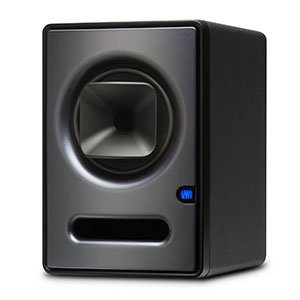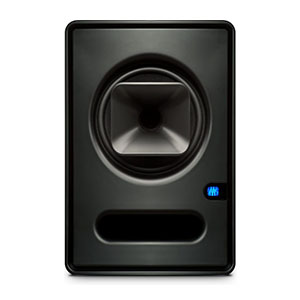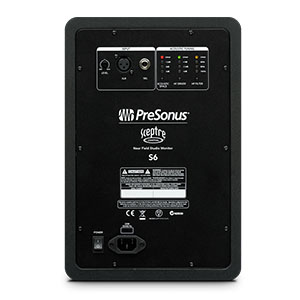- Home
- Instruments
- Gear
- Recording
- Lessons
- Reviews
- Blog


| Controls: |  |
| Features: |  |
| Performance: |  |
INTROPreSonus is mostly known for their Eris line of monitors. However, that's not all they have to offer. Meet PreSonus Sceptre S6, a very interesting coax speaker that's easily among the top studio monitors to get under $1000. Let's take a closer look and see what it has to offer.

In terms of design, there are several similarities with Eris line o f models, but Sceptre S6 is ultimately a whole different speaker. Cabs are fairly compact, which is one of the advantages of using a coax setup. Material of choices for this build is good old MDF, which is covered with black vinyl. Front side of the speaker features that coax driver setup and a rather large slotted reflex port underneath.
From a purely aesthetic point of view, Sceptre S6 is very easy to fit into just about any studio design. It definitely helps that these are all black. The nly thing that breaks up this color monotony are the illuminated PreSonus logos in the lower right corner of each cabinet. Lastly, the build quality is on point. Both the cabinets and controls inspire confidence. Everything feels solid and well made under the fingers.

As expected, one of the most interesting features about Sceptre S6 are its transducers. We have a 6.5″ low frequency driver that has a horn mounted 1″ diaphragm compression driver right in the middle. Both of these are actually powered by individual amps, where each transducer is rated for 90 Watts of power. Overall, you are looking at 109dB of Peak SPL at 1 meter. It is also worth mentioning that the crossover kicks in at 2.2kHz, which makes for a decent transition between drivers.
In terms of controls, you get an HF trim button, a Low Cut button and Acoustic Space button. PreSonus went with a slightly different setup, using buttons and corresponding LED lights instead of standard switches. Inputs come in form of a balanced XLR and 1/4″ TRX ports, which is more or less standard.
The performance is what makes Sceptre S6 so special. Having a coax configuration might seem like an overkill, however the results speak for themselves. Frequency response is impressively flat, transparent and natural. The other thing is the projection. Sceptre S6 is extremely good at creating a large sweet spot of 3D stereo sound. You can move quite a bit off-axis and still enjoy the clarity. In practice, this type of performance allows you to distinguish even the slightest and most subtle details in your mix.
That 6.5″ low frequency driver digs fairly deep into the range, delivering a very tight but wide bass. With 180 Watts per speaker, you have plenty of head room should you need it. Positioning the speakers is fairly easy due to a wide sweet spot, but also due to front firing reflex ports. PreSonus Sceptre S6 will work fairly well even in smaller studios.
At the end of the day, Sceptre S6 is not just a novelty coax speaker. The performance benefits it offers are tangible to say the least. It has plenty of power, a nice and wide sweet spot, and most importantly, great overall response. These monitors are definitely worth looking into.
For more info about the PreSonus Sceptre S6, click here.
For more studio monitor under $1000 you might like, click here.

Maty J says
Thanks for using my YouTube video! Check us out at Maty J & Tam for other reviews and content 😀